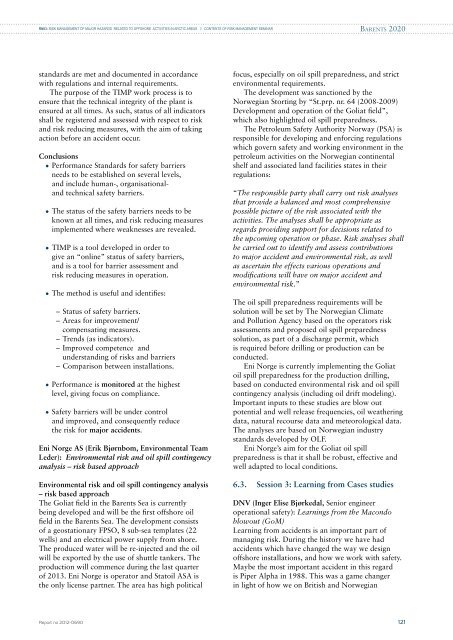phase 4 report - DNV
phase 4 report - DNV
phase 4 report - DNV
Create successful ePaper yourself
Turn your PDF publications into a flip-book with our unique Google optimized e-Paper software.
RN03: RISK MANAGEMENT OF MAJOR HAZARDS RELATED TO OFFSHORE ACTIVITIES IN ARCTIC AREAS // Contents of Risk Management SeminarBarents 2020standards are met and documented in accordancewith regulations and internal requirements.The purpose of the TIMP work process is toensure that the technical integrity of the plant isensured at all times. As such, status of all indicatorsshall be registered and assessed with respect to riskand risk reducing measures, with the aim of takingaction before an accident occur.Conclusions• Performance Standards for safety barriersneeds to be established on several levels,and include human-, organisationalandtechnical safety barriers.• The status of the safety barriers needs to beknown at all times, and risk reducing measuresimplemented where weaknesses are revealed.• TIMP is a tool developed in order togive an “online” status of safety barriers,and is a tool for barrier assessment andrisk reducing measures in operation.• The method is useful and identifies:––Status of safety barriers.––Areas for improvement/compensating measures.––Trends (as indicators).––Improved competence andunderstanding of risks and barriers––Comparison between installations.• Performance is monitored at the highestlevel, giving focus on compliance.• Safety barriers will be under controland improved, and consequently reducethe risk for major accidents.Eni Norge AS (Erik Bjørnbom, Environmental TeamLeder): Environmental risk and oil spill contingencyanalysis – risk based approachEnvironmental risk and oil spill contingency analysis– risk based approachThe Goliat field in the Barents Sea is currentlybeing developed and will be the first offshore oilfield in the Barents Sea. The development consistsof a geostationary FPSO, 8 sub-sea templates (22wells) and an electrical power supply from shore.The produced water will be re-injected and the oilwill be exported by the use of shuttle tankers. Theproduction will commence during the last quarterof 2013. Eni Norge is operator and Statoil ASA isthe only license partner. The area has high politicalfocus, especially on oil spill preparedness, and strictenvironmental requirements.The development was sanctioned by theNorwegian Storting by “St.prp. nr. 64 (2008-2009)Development and operation of the Goliat field”,which also highlighted oil spill preparedness.The Petroleum Safety Authority Norway (PSA) isresponsible for developing and enforcing regulationswhich govern safety and working environment in thepetroleum activities on the Norwegian continentalshelf and associated land facilities states in theirregulations:“The responsible party shall carry out risk analysesthat provide a balanced and most comprehensivepossible picture of the risk associated with theactivities. The analyses shall be appropriate asregards providing support for decisions related tothe upcoming operation or <strong>phase</strong>. Risk analyses shallbe carried out to identify and assess contributionsto major accident and environmental risk, as wellas ascertain the effects various operations andmodifications will have on major accident andenvironmental risk.”The oil spill preparedness requirements will besolution will be set by The Norwegian Climateand Pollution Agency based on the operators riskassessments and proposed oil spill preparednesssolution, as part of a discharge permit, whichis required before drilling or production can beconducted.Eni Norge is currently implementing the Goliatoil spill preparedness for the production drilling,based on conducted environmental risk and oil spillcontingency analysis (including oil drift modeling).Important inputs to these studies are blow outpotential and well release frequencies, oil weatheringdata, natural recourse data and meteorological data.The analyses are based on Norwegian industrystandards developed by OLF.Eni Norge’s aim for the Goliat oil spillpreparedness is that it shall be robust, effective andwell adapted to local conditions.6.3. Session 3: Learning from Cases studies<strong>DNV</strong> (Inger Elise Bjørkedal, Senior engineeroperational safety): Learnings from the Macondoblowout (GoM)Learning from accidents is an important part ofmanaging risk. During the history we have hadaccidents which have changed the way we designoffshore installations, and how we work with safety.Maybe the most important accident in this regardis Piper Alpha in 1988. This was a game changerin light of how we on British and NorwegianReport no 2012-0690 121






![Risk Based Pipeline Integrity Management [Compatibility Mode] - DNV](https://img.yumpu.com/50424229/1/190x146/risk-based-pipeline-integrity-management-compatibility-mode-dnv.jpg?quality=85)









